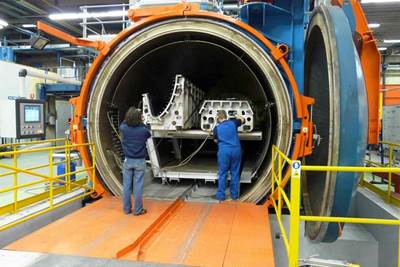Industrial composite autoclaves feature advanced control, turnkey options
CAMX 2024: Designed and built with safety and durability in mind, Akarmark delivers complete curing autoclave systems for a variety of applications.
Share
Source | Akarmark
(EskiÅŸehir, Türkiye) offers integrated composite curing autoclaves with advanced control systems. The company also provides turnkey solutions for the industry, including auxiliary equipment such as vacuum, cooling and pressurization systems, and loading carts.
Since 1990, Akarmak has been manufacturing industrial autoclaves with the latest technology for various industrial applications — composite curing, glass lamination, tire coating/rubber curing, building materials (aerated concrete), food and waste sterilization. With its experience, robust infrastructure and comprehensive autoclave production program, it delivers complete autoclave systems with rapid-closing bayonet door systems up to 5 m in diameter and 63 m in length. Working dimensions up to 6.5 m in diameter and 20 m in length are possible, with operating capability up to 400°C and 70-bar pressure.
All autoclaves feature control software with optimized process control, part identification, reporting and tracking capabilities, facilitating process analysis, historical operation tracking, calibration and maintenance. Additional features include an optimum air circulation system and homogeneous heat distribution; heat insulation and cooling control via user-friendly heating and cooling battery systems; and turnkey solution options (cooling, vacuum, loading systems and pressurization, e.g., air and nitrogen).
Akarmak’s autoclaves are used worldwide by its clients in the aerospace, motorsport and ballistics sectors, to name a few. The company says that its products are fully compliant with international autoclave specifications such as Boeing BSS-7123 (formerly D6-49327), BAC 5317, Airbus AP-3222, Nadcap and AMS2750. To certify its autoclaves manufactured in accordance with CE, ASME, and other certifications, the company collaborates with internationally recognized certification organizations such as Bureau Veritas and TUV.
Related Content
-
New brand identity launch aligns with nonwoven portfolio offerings
CAMX 2024: James Cropper, formerly known as Technical Fibre Products, is bringing its new name to the U.S. composites industry, highlighting its specialization in carrier, surface and fire protection veils, among other products.
-
Automated RTM, SQRTM enhance aerospace composites serial production transition
CAMX 2025: Coexpair, in partnership with Radius Engineering, combines equipment development and fabrication with engineering of composite parts, demonstrated in its European customer support, deliveries.
-
Exacting chemistry streamlines composite surface prep
CAMX 2025: Hawkeye Industries exhibits Duratec, Styrosafe, Styroshield and Aqua-Buff brands for optimal composites coating, compounds and polish solutions options.
Related Content
New brand identity launch aligns with nonwoven portfolio offerings
CAMX 2024: James Cropper, formerly known as Technical Fibre Products, is bringing its new name to the U.S. composites industry, highlighting its specialization in carrier, surface and fire protection veils, among other products.
Read MoreAutomated RTM, SQRTM enhance aerospace composites serial production transition
CAMX 2025: Coexpair, in partnership with Radius Engineering, combines equipment development and fabrication with engineering of composite parts, demonstrated in its European customer support, deliveries.
Read MoreExacting chemistry streamlines composite surface prep
CAMX 2025: Hawkeye Industries exhibits Duratec, Styrosafe, Styroshield and Aqua-Buff brands for optimal composites coating, compounds and polish solutions options.
Read MoreVIDEO: High-rate composites production for aerospace
Westlake Epoxy’s process on display at CAMX 2024 reduces cycle time from hours to just 15 minutes.
Read MoreRead Next
Plataine unveils AI-based autoclave scheduling optimization tool
The Autoclave Scheduler is designed to increase autoclave throughput, save operational costs and energy, and contribute to sustainable composite manufacturing.
Read MoreST Engineering MRAS presents initiatives to drive autoclave efficiency, automation
During a JEC World 2024 panel discussion, the company revealed ways in which it is maximizing throughput and efficiency of its autoclaves and enhancing composites production processes.
Read MoreUltrasonic welding for in-space manufacturing of CFRTP
Agile Ultrasonics and NASA trial robotic-compatible carbon fiber-reinforced thermoplastic ultrasonic welding technology for space structures.
Read More






